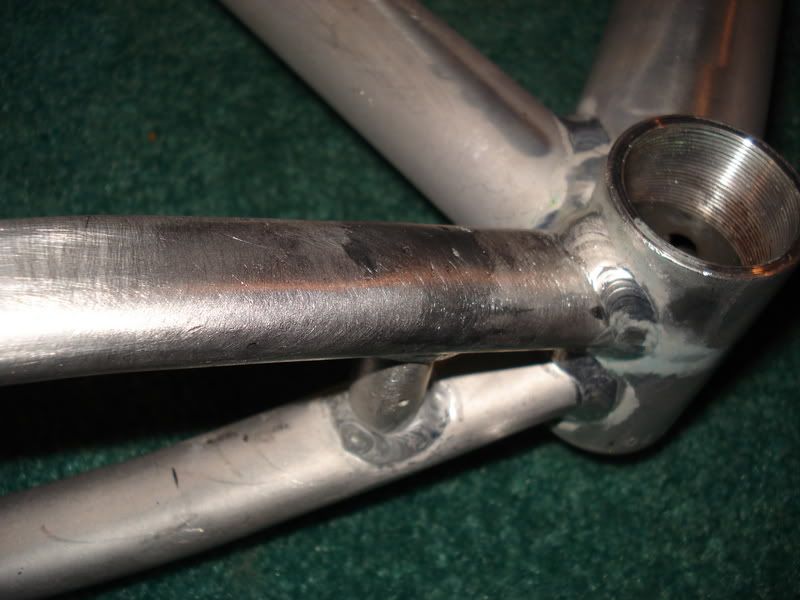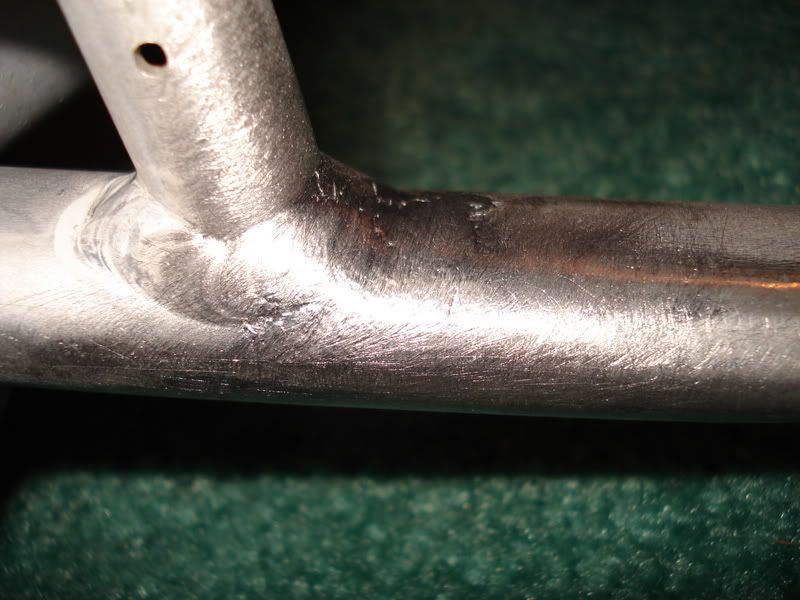http://www.aluminumrepair.com/login/...ochure/web.wmv
After asking the seller of this stuff whether or not it will work on a bike frame, he said yes, he uses it all the time, and it works extremely well. It is apparently a stronger weld than TIG welding, as the alloy is much stronger, harder, and more flexible. Almost like steel. However, make sure you practice alot to make sure you do it right.
You can use propane, MAAP, or an air-acetylene torch. The latter two work best.
Well, I decided to give this new HTS-2000 brazing rod a try. I was very skeptical. However, after practicing with it (using an air-acetylene turbo-torch at work), I was unbelievably amazed at the results. I plan to use it in the future if I ever need to make repairs like this again. Sure beats buying a whole new frame.
My first use of it was exactly by instructions. A good brushing or filing to remove the surface oxide is required. The one step that is
absolutely necessary is the tinning process. And I mean really tin the stuff. You need to really make sure you get it up to temperature befoie tinning will make it penetrate the surface molecules. Simply brushing as soon as the rod melts won't do it. You need to continue heating a little more for a couple seconds, to get it a few degrees hotter which opens the pours in the aluminum. Especially when working with 7005 alloy. Once it is properly tinned, it will in fact stick and adhere to aluminum stronger than a TIG weld. Hard to admit, but I tested it myself, and the stuff is amazing. My first reaction when beating this test piece with a hammer was, "What the... NO WAY!!!".
As you can see below, I brazed a piece of small aluminum bracket materail at a 90deg angle, then beat it with my hammer to see if I could make the weld break. It would not. The aluminum tore, long before the weld gave in.

The next test was the same as in the video above. I punched a hole in the can then brazed over the hole. I then tried to punch through the new braze. It crushed the can, and would not penetrate the weld. This brazing rod is harder, stronger, and more flexible than the base aluminum. So, it simply won't brake before the base material. If the aluminum fails it will fail nearby, before the weld does.

-----------------------------------------------------------------------------
Now, comes my frame. I had a crack that was from a jammed chain between the rings and the chainstay, which gouged the stay and caused an acute crack almost all the way around, yet not completely. It went around the inner side as well just behind the TIG weld to the bridge. I used a jewelers file to "V" out the crack, then tinned and filled the whole area with the HTS-2000. Also, to strengthen the surrounding area to help prevent further nearby stress fractures, I heated an built up about a 1" wide area (about 1/16" thick) all the way around the stay. I then filed the whole thing smooth. The weld now looks smoother than the original TIG weld. By all rights, since this stuff is stronger than aluminum, you could essentially build an entire frame if you so desired. Now, that it is repaired, the frame has been primed/sanded, and is ready for paint.


Will it hold? Only time will tell.
However, if beating it with a hammer, like I did above, is any indication as to the strength of this repair, it should be fine. I will take it easy to start with, then see how well it holds up to some tougher trails later on.